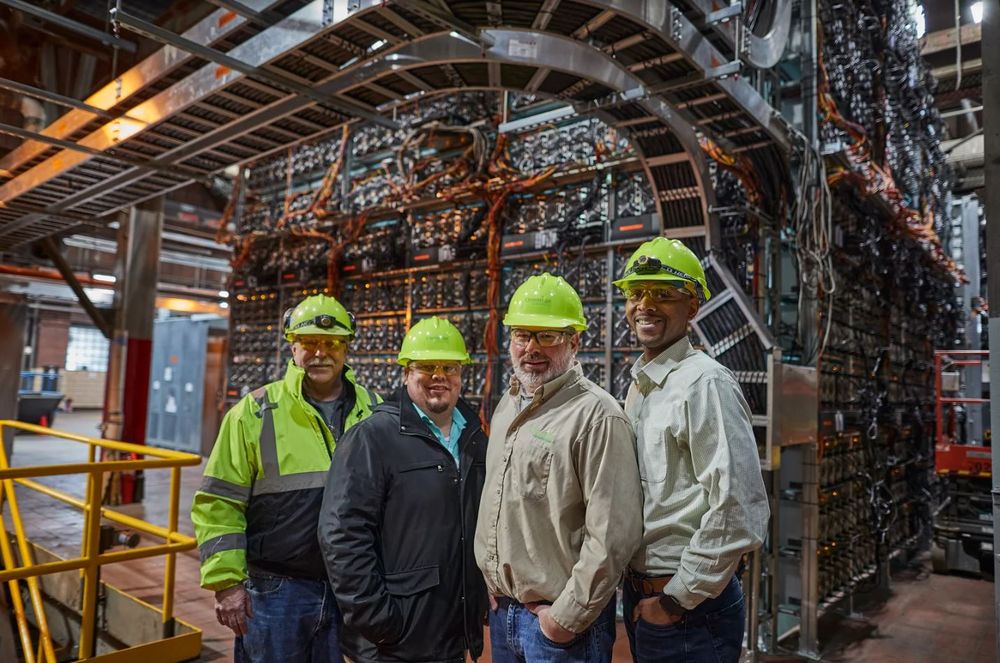DRESDEN, Mar. 6, 2020 — The Greenidge Generation power plant has shifted from intermittent to full-time operation to accommodate a new Bitcoin mining operation capable of generating about $50,000 of the virtual currency daily.
The plant recently installed and tested 7,000 crypto mining machines that draw 14 megawatts of the plant’s total 106 MW capacity, according to media reports.
The plant “hopes to increase the capacity from its current 14 MW to 106 MW” by attracting new investor “partnerships,” bitcoin.com reported today.
That website went on to speculate the Greenidge’s operation, which exploits its own cheap “behind-the-meter” electric power that never reaches the energy grid, “will likely spur other natural gas firms to start (cryptocurrency) mining.”
 Greenidge employees stand near Bitcoin mining equipment.
Greenidge employees stand near Bitcoin mining equipment.
Bitcoin is a worldwide digital currency whose transactions are monitored and confirmed by a decentralized group of computer centers that now includes Greenidge. Those centers are rewarded for their auditing activity with Bitcoin tokens, which traded for about $9,125 today. Here is a New York Times primer on Bitcoin, and here is an explanation of bitcoin mining.
Greenidge’s move into Bitcoin mining represents a dramatic change for the former coal-fired plant that was built in 1937 and mothballed in 2011.
After Atlas Holdings LLC bought the shuttered plant, the Greenwich, Conn., private equity firm converted it to burn natural gas instead of coal.
That conversion was controversial because critics questioned the need for a relatively small plant that was designed to operate only intermittently during periods of peak energy demand and to sit idle much of the year.
Allowing the restart as a gas-burner also clashed with the Cuomo Administration’s touted goal of shifting the state from fossil fuels to renewable energy sources.
But after Atlas officials contributed generously to Cuomo’s reelection campaign and hired a key Cuomo campaign ally, the state awarded the Greenidge conversion a $2 million grant, and state regulators granted Atlas operating permits that relied on relaxed interpretations of state and federal environmental laws.
For example, the state is allowing the plant to wait until 2022 to comply with federal Clean Water Act requirements for screening on its massive water intake pipe that runs into Seneca Lake. Without screens, the intake pipe mangles millions of fish.
And cleanup of the plant’s coal ash landfill— originally mandated to be complete by 2016— has been repeatedly postponed by the state Department of Environmental Conservation.
The Sierra Club filed lawsuits challenging several of those permits on those and other issues, but Greenidge prevailed in court.
The water intake pipe is key to that plant’s cooling system, which also cools the Bitcoin mining rigs.
In fact, installed cooling systems and cheap energy are two standard requirements for competitive Bitcoin mining operations.
Another shuttered coal-powered plant on Cayuga Lake is also exploring potential conversion to a data center (though not necessarily a Bitcoin mining).
Like Greenidge, it holds permits to use tens of millions of gallons a day of unrecycled lake water as a potential coolant for banks of computers. Both plants dump torrents of heated water back into the lakes, disturbing aquatic life. (New plants are required to recycle their coolant waters).
The Cayuga plant has tried and so far failed to win regulatory approval to convert to a gas-power electricity generator. So it would have to buy its power from the energy grid to operate as a data center.
The owners of that plant have sought state allocations of below-market-cost hydro power as well as state grant money from Empire State Development. The Cayuga plant owners have said the data center is dependent on such state support.
For its Bitcoin mining operation, Greenidge draws directly from the energy it produces from burning natural gas on site, rather than purchasing more expensive energy through the grid system.

Greenidge has installed banks of computers used to mine Bitcoin.
That provides savings that will help the plant remain competitive with other Bitcoin miners worldwide, especially in light of plans to cut Bitcoin rewards in half in May.
One Bitcoin mining insider told Waterfront that competition among miners is growing increasingly fierce as new players constantly enter the field. “The miners can be large server farms or a kid in a dorm room — they’re all monitoring and updating the blockchain,” he said.
“If bitcoin is profitable to mine at $8,000 today (when a token traded in the $9,125 range), it will be $16,000 after the halving. If the bitcoin price doesn’t rise to that level, (many) miners will be losing money.”
Dale Irwin, Greenidge’s manager, did not return phone calls seeking details.
But Tim Rainey, chief financial officer at Greenidge, told Bloomberg News:
“We are in a favorable market position regardless of how the halving materializes. Due to our unique position as a co-generation facility, we are able to make money in down markets so that we’re available to catch the upside of volatile price swings.”

